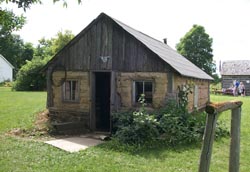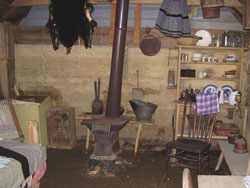For further information
contact us at: 320-274-8489,
e-mail pioneerp@lakedalelink.net or fax
320-274-9612.
|
|
|
|
Historically, sod houses, log
cabins, dug outs or any other shanty all had one thing in
common. They were temporary dwellings at best. When the
government land was purchased or claimed, the settler was
required to put up a house.
Sometimes
branches and sod were used for the roof with pieces of
wood for supports. Windows and doors were made from old
boxes that came with the pioneers on their long journey.
The floor was hard-packed earth, which could be swept and
sometimes sprinkled with water to keep it from being
dusty.
As materials
became available, improvements were made. A board roof
was the first improvement. Next came board walls of rough
lumber and finally a wood floor.
7) Sod
Home
This replica
of a claim shanty was built on this site in 1976 and
finished in 1977. It contains elements of the sod house
as well as natural evolution of improvements.
This claim
shanty housed an entire family. Several photographs on
the wall show life on the prairie. The furnishings in the
home include: a bed with rope instead of wire springs, a
straw mattress, and an old trunk that held their
belongings.It was also common to have the skull of an
animal hanging over the door.
Because of a
lack of wood, "buffalo chips" were burned for heat. Rain
was caught in the rain barrel for washing. The pioneer
women did the washing outside when weather permitted. The
wash bench held the wash tub with the soap and water,
thus saving her from bending over so far.
The well
outside a claim shanty was simply a hole that was dug
until ground water was reached. A pail attached to a rope
was let down, and the water flowed into a pail. Turning a
handle on a rod brought it up.



